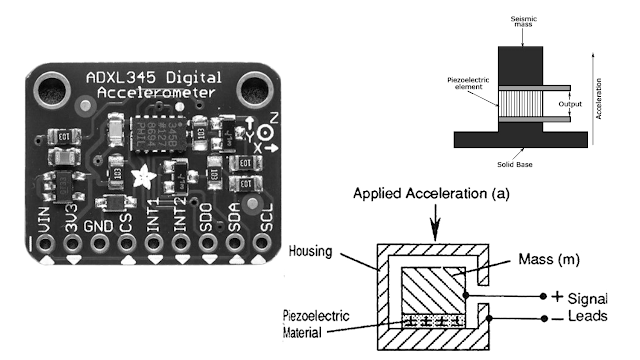Accelerometers sensor how It works and applications
Accelerometers sensor
Accelerometer
An accelerometer is an electro- mechanical device that measures proper acceleration forces. These forces may be static like the constant force of gravity pulling at your feet, or they could be dynamic – caused by moving and vibrating the accelerometer.
Principle
The working principle of an accelerometer is based on PIEZO-ELECTRIC EFFECT (due to accelerative forces) and on the DISPLACEMENT SENSING (based on displacement of mass).
How it works
In most of the cases working of an ACCELEROMETER is based on voltage generation and its further calculations which leads to the determination of acceleration where as some other involve the measurement of displacement of mass.
Types of accelerometer
There are basically two types of accelerometer frequently used for measurement of acceleration
Piezo electric accelerometer
Displacement sensing or seismic type accelerometer
It employs the piezo electric effect of certain materials to measure dynamic changes. It converts one form of energy into another and provide electrical signal of measured amount.
Working Principle
The working principle of this is based on “NEWTONS THIRD LAW” . The force exerted on the material can be observed in the change in the electrostatic force or voltage generated by the piezoelectric material.
Fastened on the base which act as a spring and squeezes the mass against crystal for acceleration determination.
Leads to voltage generation and fluctuation in voltage leads to measurement of imposed acceleration.
Sensor consist of piezoelectric crystal sand witched between two electrodes with a mass placed on it
Advantages
- Rugged and Inexpensive
- High Impedance
- High sensitivity
- High frequency response
Disadvantages
- Sensitive to temperature
- Hysteresis error
- Less longevity
- Decreased efficiency with time
Seismic accelerometer
In displacement sensing accelerometer the displacement of a mass resulting from an applied force is measured and correlated to the acceleration .Here a common spring – mass-damper system which accomplishes the task of acceleration measurement through displacement.
Working Principle
The working principle of this is based on mass-spring-damper combination and similarly acceleration calculation from displacement.
The mass is supported by a spring and connected to the housing frame which is attached to a machine.
Relative mass movement is sensed and indicated by an electrical displacement transducer.
Correspondingly displacement and velocity are measured and further acceleration are measured.
Advantages
- Easy Calculation
- Simple and reliable
- Durable and efficient
Disadvantages
- Spring system is not always accurate
- Fluctuation in mass leads to wrong calculation.
Application of Accelerometer
- Acceleration and vibration calculation in vehicles
- In industries for monitoring machines
- Building and structural monitoring
- Medical application and navigation
- Transport


Comments
Post a Comment